Let’s dive into the question: which cricket stadiums stand as the largest in the world?
World’s Biggest Cricket Stadium: Where Grandeur Meets Sporting Passion
Cricket has been a popular sport for centuries, it is cherished by fans and bettors all around the world. The cricket stadium, or “ground” in a professianal language, is an important part of the game’s culture and atmosphere. Just like any other professional sport, having the ideal playing conditions can be key to success. Now, let’s dive into the grand question: which cricket stadiums stand as the largest in the world?
Table of Contents
- 1 Understanding Cricket Stadium Requirements
- 2 Which are the largest cricket grounds in India?
- 2.1 Narendra Modi Stadium, Ahmedabad
- 2.2 Eden Gardens, Kolkata
- 2.3 The Shaheed Veer Narayan Singh International Cricket Stadium, Naya Raipur
- 2.4 The Rajiv Gandhi International Cricket Stadium, Hyderabad
- 2.5 The DY Patil Stadium, Navi Mumbai
- 2.6 Chepauk Stadium, Chennai
- 2.7 Ekana Cricket Stadium, Lucknow
- 2.8 JSCA International Cricket Stadium, Ranchi
- 2.9 The Vidarbha Cricket Association Stadium, Nagpur
- 2.10 Barabati Stadium, Cuttack
- 3 List of Largest Cricket Stadiums in the World
- 4 Biggest Cricket Stadium in India: Latest developments
- 5 Conclusion
- 6 FAQs
Understanding Cricket Stadium Requirements
Cricket stadiums, like all sports venues, need to adhere to specific standards and requirements. At the core, these requirements are designed to ensure a fair and consistent playing environment, as well as offer spectators a comfortable and engaging experience.
Firstly, the playing surface, or the cricket pitch, is a vital component of any cricket stadium. It needs to be a flat strip of 22 yards (20.12 m) in length and 10 feet (3.05 m) in width. The quality of the pitch can greatly influence the outcome of a match, and, as such, it is meticulously prepared and maintained. Moreover, the stadium should possess facilities for pitch preparation and maintenance, including groundskeeping equipment.
Secondly, the stadium requires ample seating for spectators. The capacity of the stadium is often a reflection of the popularity of cricket in the region, and larger stadiums are usually found in countries where cricket is a major sport. The seating should provide a clear view of the pitch, and safety measures such as adequate exit points and first aid facilities must be in place. Additionally, amenities like food and beverage counters, restrooms, and parking facilities add to the overall viewer experience.
Lastly, modern cricket stadiums also incorporate advanced technology for broadcasting purposes. High-quality lighting is required for night matches, and facilities for media personnel, including commentators and camera crews, are essential. Scoreboards, either manual or electronic, add to the excitement of the match and keep spectators informed about the ongoing match situation.
Which are the largest cricket grounds in India?
Narendra Modi Stadium, Ahmedabad
The Narendra Modi Stadium, formerly known as the Sardar Vallabhbhai Patel Cricket Stadium, is a cricket stadium located inside the Sardar Vallabhbhai Patel Sports Enclave in Ahmedabad, India. As of 2022, it is the largest stadium in the world, with a seating capacity of 132,000 spectators. The stadium is owned by the Gujarat Cricket Association and is a venue for Test, ODI, T20I, and Indian Premier League cricket matches. It was constructed in 1983 and was first renovated in 2006. In 2015, the stadium was closed and demolished before being completely rebuilt by February 2020, with an estimated cost of ₹800 crore (US$100 million). Apart from cricket, the stadium has hosted several programs arranged by the Government of Gujarat. It has hosted matches during the 1987, 1996, and 2011 Cricket World Cups.
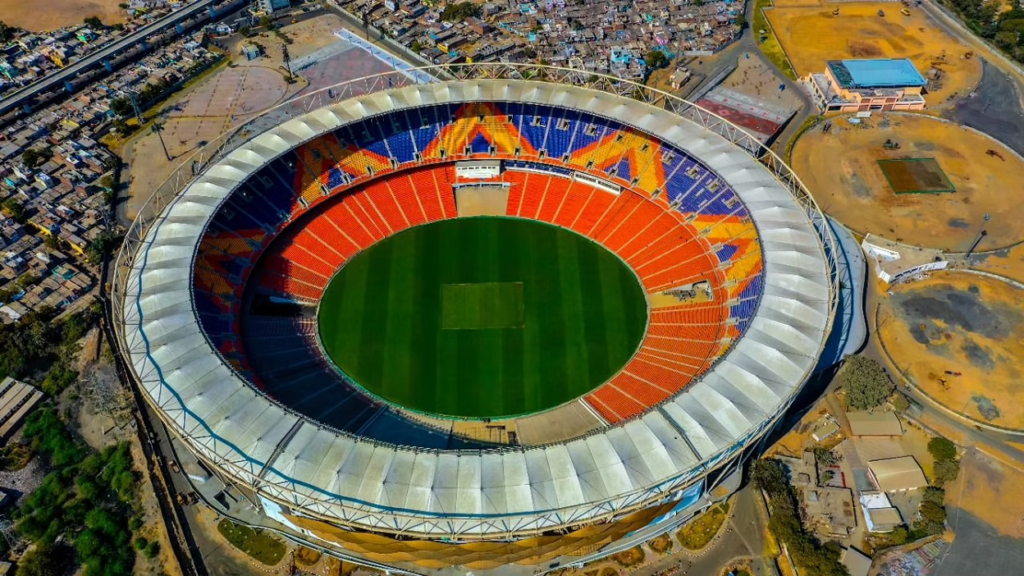
Eden Gardens, Kolkata
Eden Gardens, often dubbed the “Cricket’s Colosseum,” is one of the oldest and most famous cricket venues in India, it is an iconic stadium situated in the heart of Kolkata. With its sprawling capacity of 66,000 people, it stands as one of the largest cricket stadiums not just in India, but globally. The stadium has seen numerous historic matches since 1934 and has been a witness to iconic performances by cricketing legends. The electric atmosphere and the passionate crowd make it an unparalleled experience for both playing teams and spectators. t is also home to some of the most iconic moments in Indian cricket such as Virender Sehwag’s triple century against Pakistan in 2004 and Sachin Tendulkar’s 200th Test match.

The Shaheed Veer Narayan Singh International Cricket Stadium, Naya Raipur
The Shaheed Veer Narayan Singh International Cricket Stadium, also known as the Raipur International Cricket Stadium, is a cricket stadium located in Naya Raipur, Chhattisgarh, India. The stadium was established in 2008 and has a seating capacity of approximately 65,0001. It is named after Veer Narayan Singh Binjhwar, a landlord from Sonakhan who spearheaded the 1857 war for Indian independence in Chhattisgarh. The stadium is owned by the Government of Chhattisgarh and is operated by the Chhattisgarh State Cricket Sangh. It is the home ground of the Chhattisgarh cricket team and has also served as a second home venue for the Delhi Capitals in the Indian Premier League (IPL). The first international cricket match played at this stadium was an ODI between India and New Zealand in 2023, which was won by India.
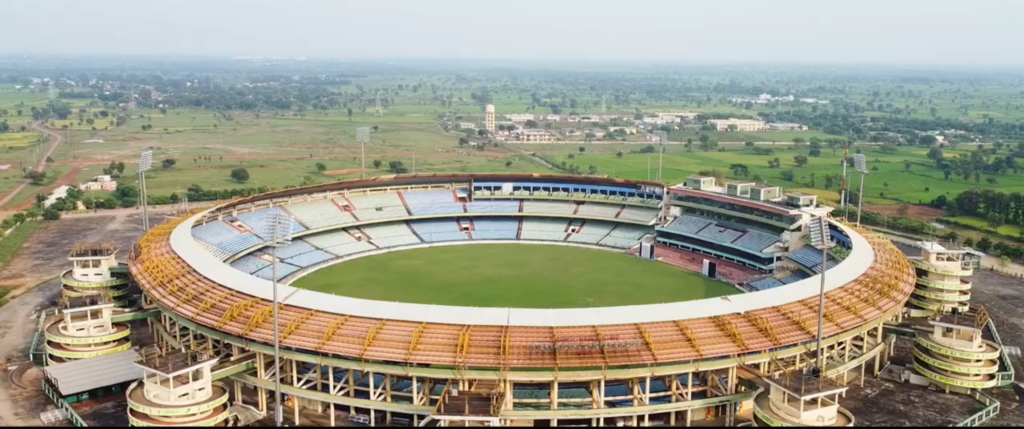
The Rajiv Gandhi International Cricket Stadium, Hyderabad
The Rajiv Gandhi International Cricket Stadium is a cricket stadium located in the eastern suburb of Uppal, Hyderabad, Telangana, India. It has a maximum seating capacity of 55,000 and extends across 16 acres (65,000 m²) of land. The stadium serves as the home ground for the Hyderabad Cricket Association and the Indian Premier League team Sunrisers Hyderabad. As of 3 March 2019, it has hosted 5 Tests, 6 ODIs and 2 T20Is. This stadium hosted the opener and final of 2017 Indian Premier League, and also the final of 2019 Indian Premier League.

The DY Patil Stadium, also known as DY Patil Sports Stadium, is a multi-purpose stadium at D. Y. Patil campus at Nerul in Navi Mumbai, Maharashtra, India with a capacity of 55,000. It was designed by Hafeez Contractor and is a privately owned ground and is the home of D. Y. Patil Sports Academy. It is primarily a cricket stadium however is used for many different events from cricket and football, to music concerts and special events.
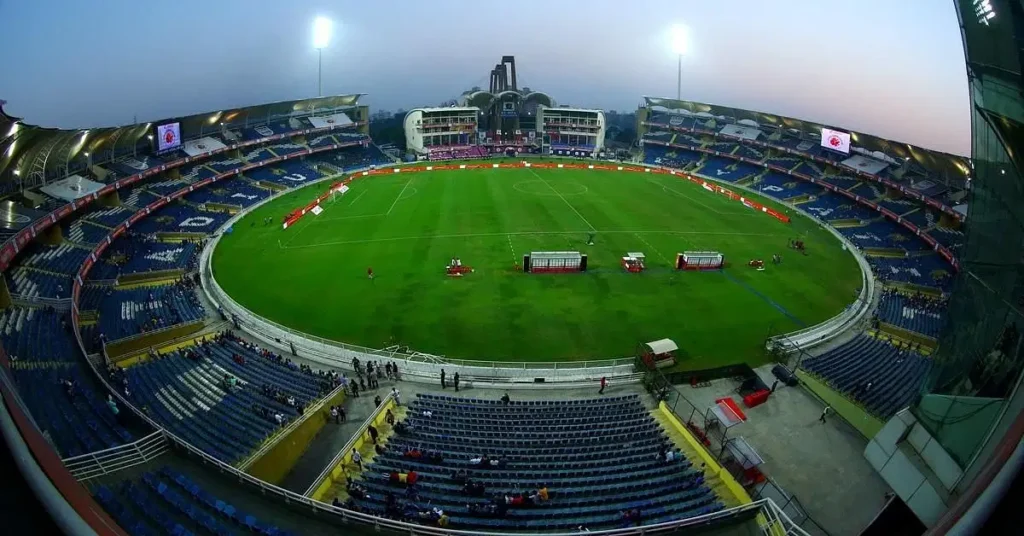
Chepauk Stadium, Chennai
M. A. Chidambaram Stadium, commonly known as the Chepauk Stadium, is a cricket stadium in Chennai, Tamil Nadu, India. Established in 1916, it is the second oldest cricket stadium in the country after Eden Gardens Kolkata. Formerly known as Madras Cricket Club Ground, the stadium is named after M. A. Chidambaram Chettiar, former president of BCCI and Head of TNCA. It is the home ground of the Tamil Nadu cricket team and the Indian Premier League team Chennai Super Kings.
Ekana Cricket Stadium, Lucknow
Bharat Ratna Shri Atal Bihari Vajpayee Ekana Cricket Stadium, generally known as Ekana Cricket Stadium, is an international cricket stadium in Lucknow, India. This arena has a seating capacity of 50,000, thus it is the fifth largest international cricket stadium of India. The stadium was previously named as “Ekana Cricket Stadium” carries significant meaning and symbolism “Ekana ” is a Sanskrit word that translates to “one” or “unity”. And later it was renamed by GoUP in the name of former Prime minister of India, Bharat Ratna Shree Atal Bihari Vajpayee.
The stadium has the longest straight boundaries in comparison to all the stadiums in India. This arena is the home ground of Uttar Pradesh cricket team and also the home venue of IPL franchise Lucknow Super Giants. In 2019, the Afghanistan cricket team used it as their home ground.
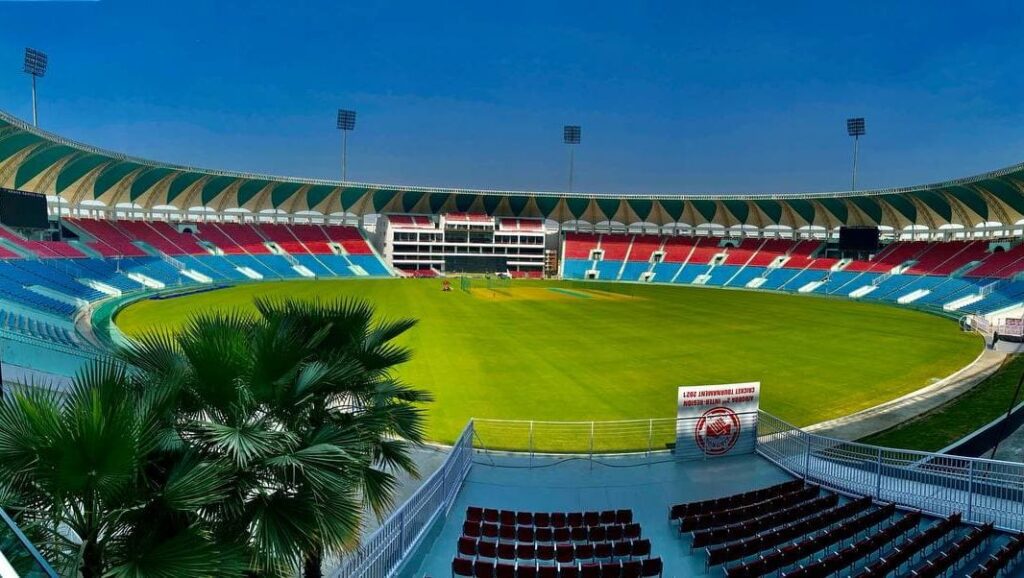
JSCA International Cricket Stadium, Ranchi
JSCA International Stadium Complex is an international cricket stadium located in Ranchi, Jharkhand, India. It is the home ground of the Jharkhand cricket team and comes under the Jharkhand State Cricket Association. The stadium was inaugurated in January 2013 and has a seating capacity of 50,000.
The first ODI match was played on January 19, 2013, between India and England1. This stadium has organized 7 matches of Indian Premier League so far.
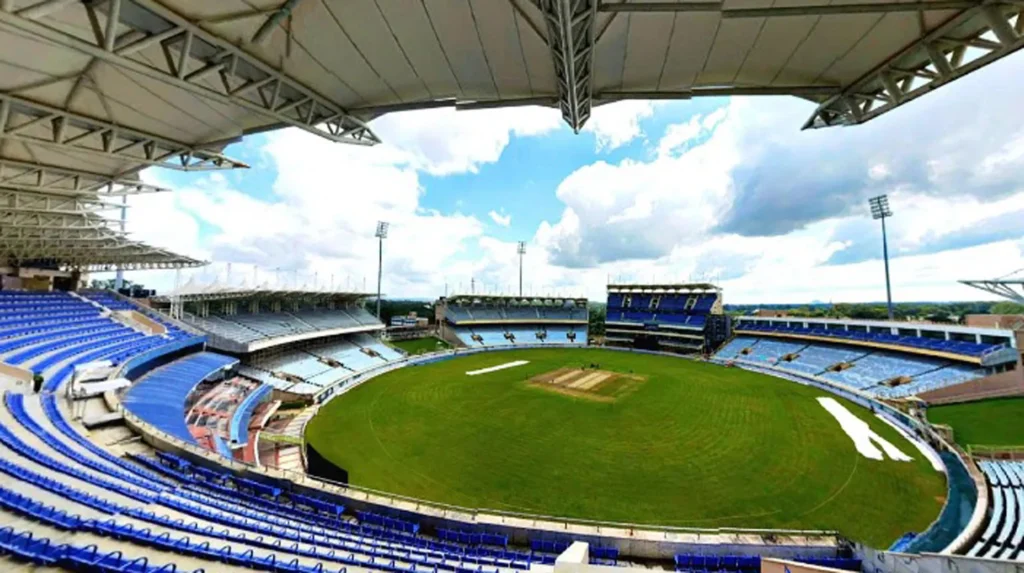
The Vidarbha Cricket Association Stadium, Nagpur
The Vidarbha Cricket Association Stadium, also known as the New VCA Stadium, is a cricket stadium located in Nagpur, Maharashtra, India. It was built in 2008 and has a seating capacity of 45,000 spectators. The stadium is the largest cricket stadium in India in terms of field area, and its qualities have been praised by the International Cricket Council. The New VCA Stadium is the home ground of the Vidarbha cricket team, which plays in the Indian domestic cricket tournaments1. It has hosted several international matches including Tests, ODIs and T20Is. The facilities at the stadium have been praised by players and commentators alike.

Barabati Stadium, Cuttack
The Barabati Stadium is an Indian sports stadium located in Cuttack, Odisha. It is used mostly for cricket and association football, and also sometimes for concerts and field hockey. The stadium is owned and operated by the Odisha Cricket Association. It is a regular venue for international cricket and is the home ground of the Odisha cricket team. The stadium has a seating capacity of 45,000 spectators. It was established in 1958 and was named after the famous Barabati fort which is a landmark in the history of the city of Cuttack. The stadium has hosted several international matches including Tests, ODIs, and T20Is.
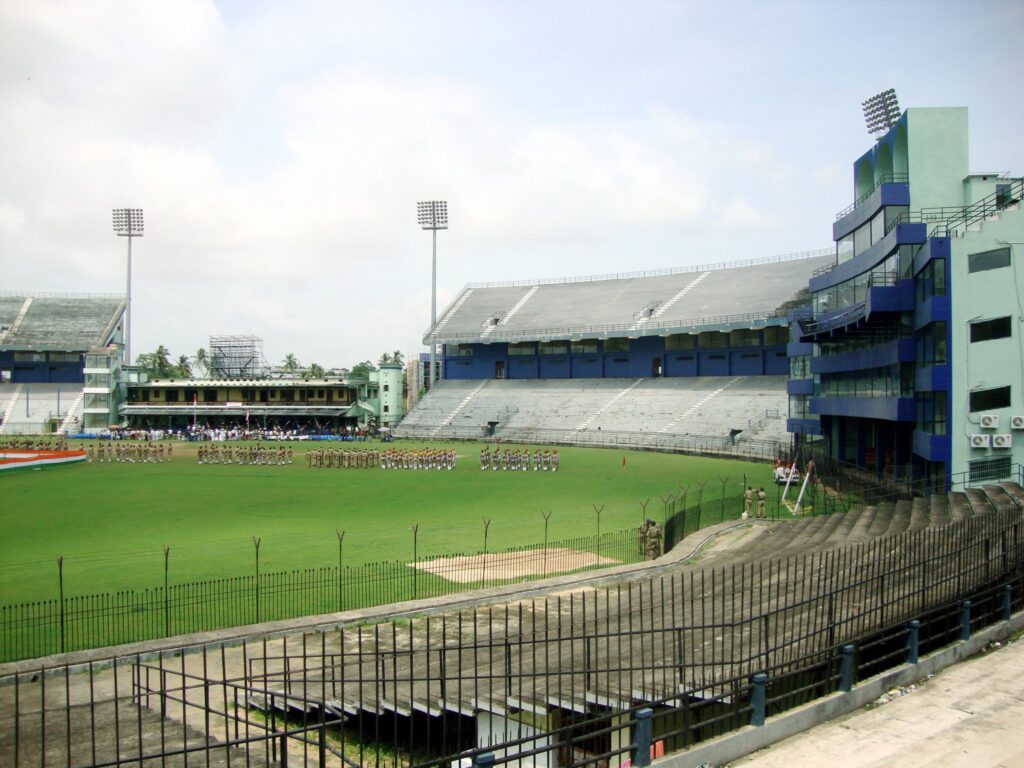
List of Largest Cricket Stadiums in the World
| Ground | Capacity | City | Country | Home Teams |
|---|---|---|---|---|
| Narendra Modi Stadium | 132,000 | Ahmedabad | India | India, Gujarat, Gujarat Titans |
| Melbourne Cricket Ground | 100,024 | Melbourne | Australia | Australia, Victoria, Melbourne Stars |
| Eden Gardens | 68,000 | Kolkata | India | India, Bengal, Kolkata Knight Riders |
| Shaheed Veer Narayan Singh | 65,400 | Raipur | India | India, Chhattisgarh, Delhi Daredevils |
| Perth Stadium | 61,266 | Perth | Australia | Australia, Western Warriors, Perth Scorchers |
| Rajiv Gandhi Stadium | 55,000 | Hyderabad | India | India, Sunrisers Hyderabad, Deccan Chargers |
| Greenfield International | 55,000 | Thiruvananthapuram | India | India, Kerala cricket team |
| Adelaide Oval | 53,583 | Adelaide | Australia | Australia, Southern Redbacks, Adelaide Strikers |
| Atal Bihari Vajpayee Ekana | 50,000 | Lucknow | India | India, Uttar Pradesh, Lucknow Super Giants |
| M. A. Chidambaram | 50,000 | Chennai | India | India, Tamil Nadu, Chennai Super Kings |
Melbourne Cricket Ground (MCG), Australia
India is home to many of the largest cricket stadiums in the world. As we’ve already learned. Narendra Modi Stadium, Ahmedabad is the biggest stadium in the world with the capacity of 132,000 people. Eden Gardens, Kolkata, India is also in the world top with the capacity of 66,000 people. However, there are many other iconic venues all over the world that have hosted some of the most memorable matches in history.
The Melbourne Cricket Ground (MCG), also known locally as “The ‘G”, is an Australian sports stadium located in Yarra Park, Melbourne, Victoria. Founded and managed by the Melbourne Cricket Club, it is the largest stadium in the Southern Hemisphere, the 11th largest globally, and the second largest cricket ground by capacity. The MCG has a seating capacity of 100,024 spectators. It was opened in 1853 and has undergone several renovations since then. The MCG is used for a variety of sports including cricket, Australian rules football, rugby union, rugby league, soccer, tennis and cycling. It has also been used for other events such as concerts and field hockey.
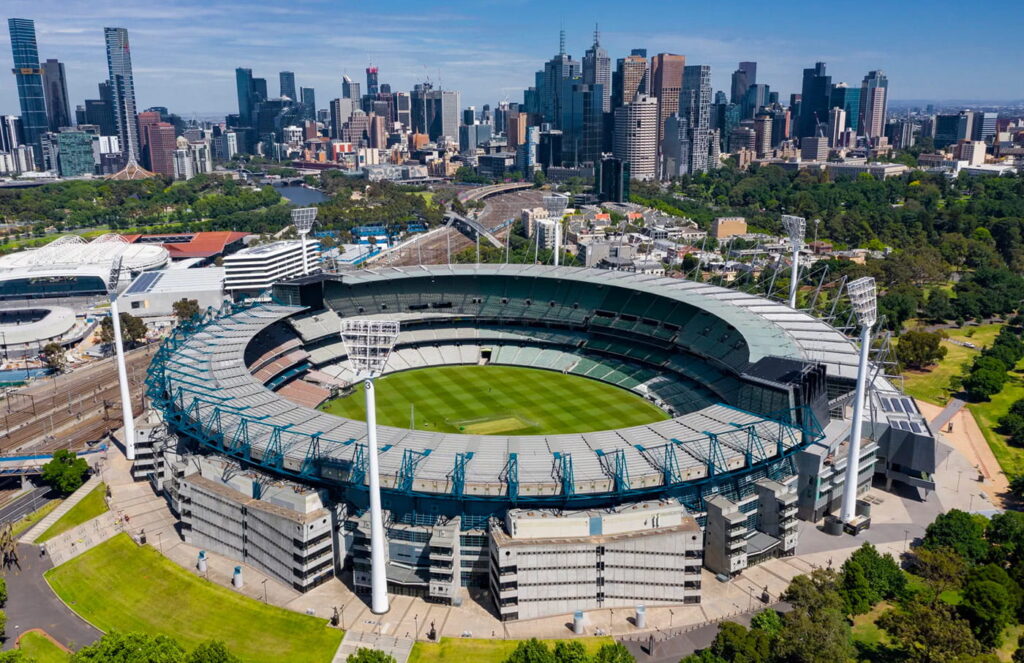
Perth Stadium, Perth, Australia
Perth Stadium, also known as Optus Stadium for sponsorship reasons, is a multi-purpose stadium located in the suburb of Burswood in Perth, Western Australia. It was completed in late 2017 and officially opened on January 21, 2018. The stadium has a total capacity of 61,266, including standing room. The stadium can be extended up to 65,000 seats for rectangular sports.
Perth Stadium is primarily used for Australian rules football and cricket. Perth’s two Australian Football League (AFL) teams – the Fremantle Football Club and the West Coast Eagles – relocated their home games from Subiaco Oval to Perth Stadium, while the Perth Scorchers play their Big Bash League home games at the venue, having previously played at the WACA Ground.
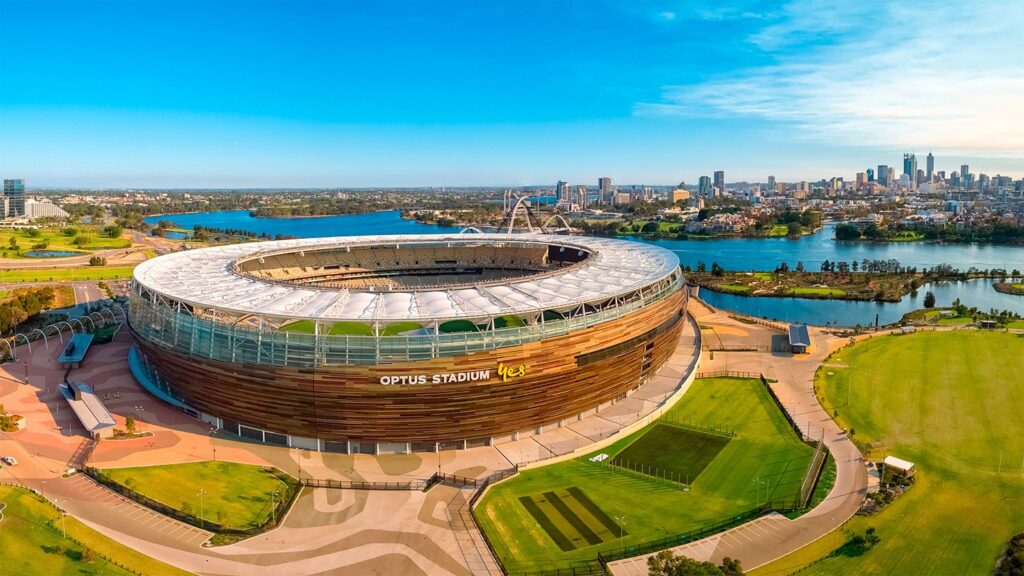
ANZ Stadium, Sydney, Australia
ANZ Stadium, also known as Stadium Australia, is a multi-purpose stadium located in the Sydney Olympic Park suburb of Sydney, New South Wales, Australia. The stadium was completed in March 1999 at a cost of A$690 million to host the 2000 Summer Olympics. It is owned by Venues NSW on behalf of the NSW Government and is operated by VenuesLive Management Services. The stadium has a seating capacity of 82,500 for rectangular sports and 81,500 for oval sports. It has been used for a variety of sports including rugby league, rugby union, cricket, Australian rules football, and association football. The stadium has also been used for concerts and other events.
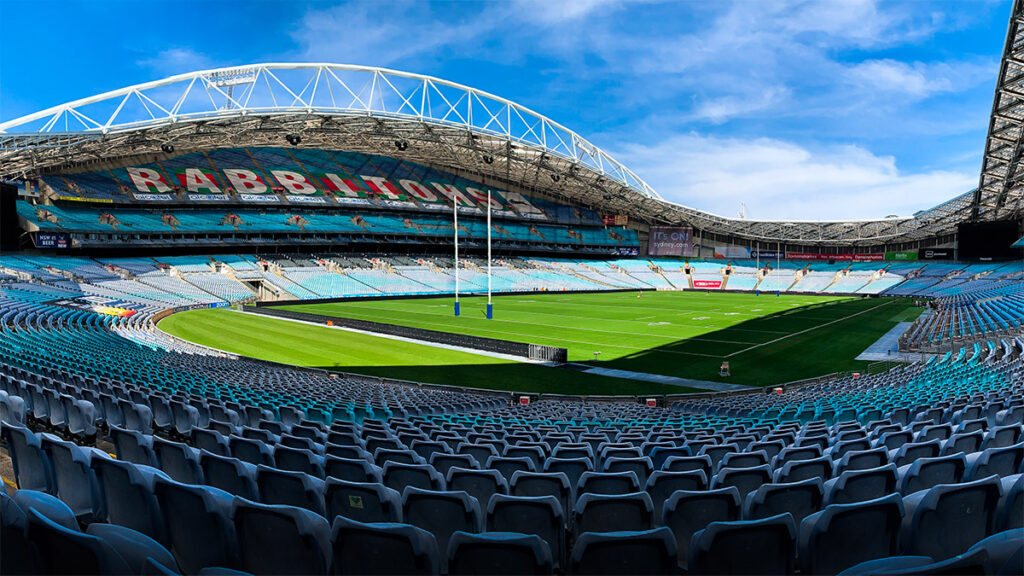
The Oval, London, England
The Oval, currently known as the Kia Oval for sponsorship reasons, is an international cricket ground located in Kennington, in the borough of Lambeth, in south London. The Oval has been the home ground of Surrey County Cricket Club since it was opened in 1845. It was the first ground in England to host international Test cricket in September 1880. The final Test match of the English season is traditionally played there. Its capacity is of 27,500 people.
In addition to cricket, The Oval has hosted a number of other historically significant sporting events. In 1870, it staged England’s first international football match, versus Scotland1. It hosted the first FA Cup final in 1872, as well as those between 1874 and 18921. In 1876, it held both the England v. Wales and England v. Scotland rugby international matches and, in 1877, rugby’s first varsity match.
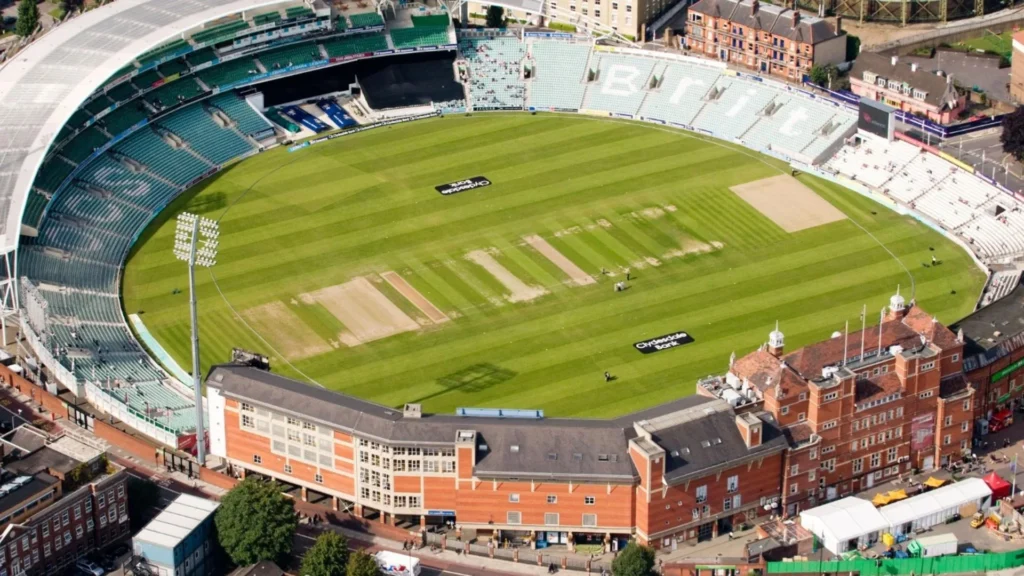
Old Trafford Cricket Ground, Manchester, England
Old Trafford Cricket Ground, also known as Emirates Old Trafford, is an international sports and events venue in Manchester. It is the home of Lancashire County Cricket Club, which has held first-class status since it was founded in 1864. The ground has a capacity of 19,000 seats and is equipped with floodlights that were installed in 2011.
Old Trafford stages international and domestic cricket, as well as concerts, conferences and events. It has hosted Tests since 1884 and remains a special venue with a rich history. Some of the most memorable moments at Old Trafford include Jim Laker’s match figures of 19 for 90 against Australia in 1956, Ian Botham’s hook shot off Dennis Lillee in 1981, and Dominic Cork’s hat-trick against West Indies in 1995.
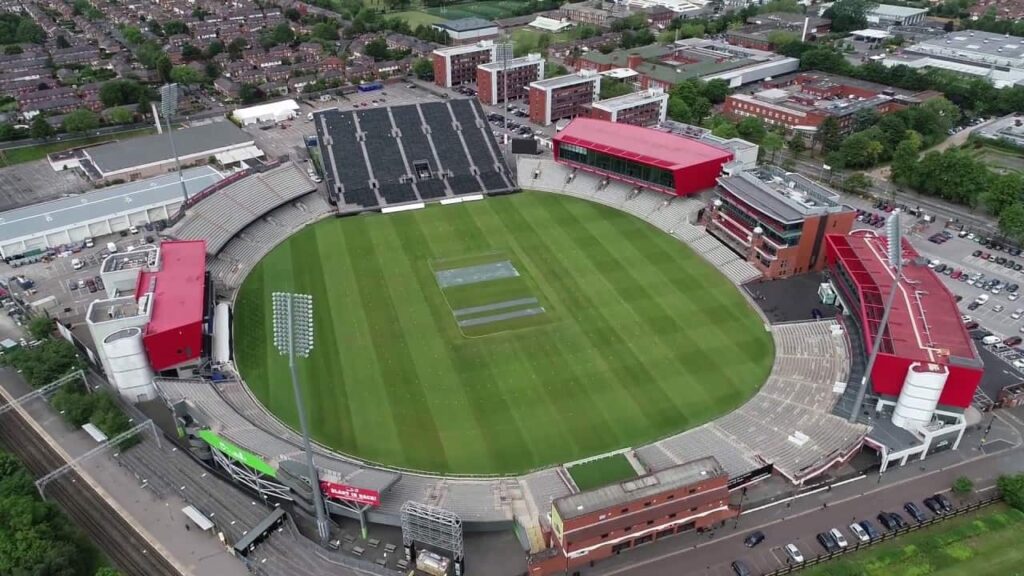
Adelaide Oval, South Australia
Adelaide Oval is a sports ground located in Adelaide, South Australia. It is situated in the parklands between the city center and North Adelaide. The stadium is primarily used for cricket and Australian rules football, but it has also played host to rugby league, rugby union, soccer, tennis, and other sports, as well as regularly being used to hold concerts.
Adelaide Oval has been the headquarters of the South Australian Cricket Association (SACA) since 1871 and the South Australian National Football League (SANFL) since 2014. The stadium is managed by the Adelaide Oval Stadium Management Authority (AOSMA).
The ground has a capacity of 53,583 seats and was transformed with a complete redevelopment that concluded in 2014. The redevelopment converted the historic ground into a world-class stadium while retaining historic elements such as the hill and scoreboard.
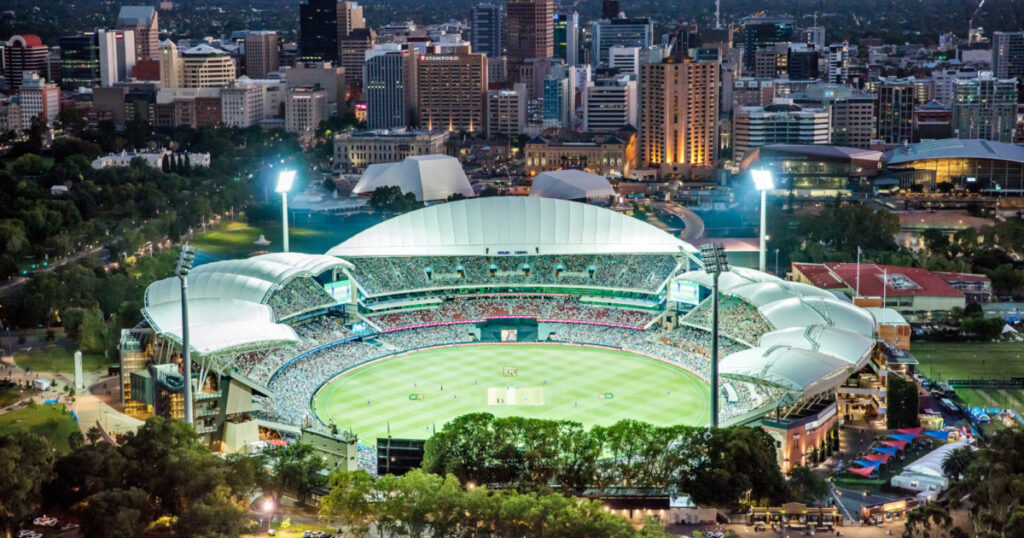
Biggest Cricket Stadium in India: Latest developments
The construction of new cricket stadiums in India has been a major endeavor over the past few years. Some of the biggest projects include the Naya Raipur International Cricket Stadium, Ekana Cricket Stadium and JSCA International Cricket Stadium. These stadiums are equipped with modern facilities to ensure the best possible experience for spectators and players alike.
In addition to these stadiums, the BCCI has also been investing in upgrading existing cricket venues across India. Some of the most notable recent projects include the refurbishment of the iconic Eden Gardens stadium and upgradation works at M Chinnaswamy Stadium and Barabati Stadium.
These developments have made it easier to host international matches in India and have enabled the country to become the home of some of the biggest cricket venues in the world. It is safe to say that India’s cricket infrastructure has come a long way over the past few years and continues to improve with each passing year.
Conclusion
India is home to some of the biggest cricket stadium in the world – Eden Gardens, in one row with the Melbourne Cricket Ground, Old Trafford and Adelaide Oval. In recent years, the BCCI has also invested heavily in upgrading existing cricket venues across India to ensure the best possible experience for spectators and players alike. With new developments in stadium infrastructure taking place every year, it is safe to say that India is well on its way to becoming one of the biggest hubs for international cricket.
From the biggest cricket stadium in India to some of the most iconic venues around the world, cricket fans have a lot to be excited about as they take part in this beloved sport. Whether its watching a match at Eden Gardens or being in attendance for an Ashes series, there are plenty of opportunities to witness history-making moments live and enjoy the best that the game has.
FAQs
What is the biggest cricket stadium in India?
The biggest cricket stadium in India is the Narendra Modi Stadium, also known as the Motera Stadium. The stadium is located in Ahmedabad and has a capacity of 132,000 spectators, making it the biggest sporting stadium in the world. The venue originally broke ground in 1983 but received significant expansion in 2017.
What is the biggest cricket stadium in the world?
Narendra Modi Stadium is also the biggest cricket stadium in the world.
What is the oldest cricket stadium in India?
The oldest cricket stadium in India is Eden Gardens in Kolkata, which was established in 1864. It is also known as the “Cricket’s Colosseum” and is the third largest cricket stadium in the world with a capacity of over 66,000 people. Eden Gardens has hosted many major matches, including the World Cup, Asia Cup, and World Cup Twenty-20. It holds a special place in the hearts of cricket fans not only in West Bengal but all over the world.
How many cricket stadiums are there in India?
According to the information I found, India has 53 international cricket venues. This is the most in any country, with 30 more than the next most: England with 23. International cricket was held in India for the first time in December 1933 when the Gymkhana Ground in Bombay played host to the India – England Test match.
What are the main technical requirements for the cricket stadium?
The size of a cricket ground (playing area) varies as its diameter can be in the range of 137.16 meters to 150 meters. The shortest boundary on a cricket field can be 59.43 meters from the cricket pitch, and the longest boundary can not exceed 82.29 meters. An international stadium typically has a minimum of 17,000 m2 of a grass field. For most practice and non-televised matches, cricket stadiums require about 250 to 350 lux. Professional matches require 500 to 750 lux. A standard cricket field has a carefully prepared grass square upon which cricket pitches can be prepared and marked for matches.


















